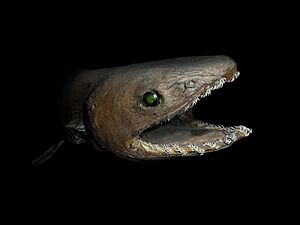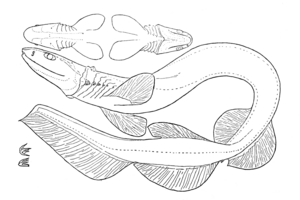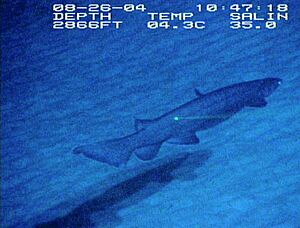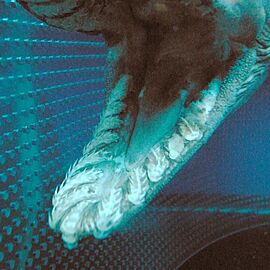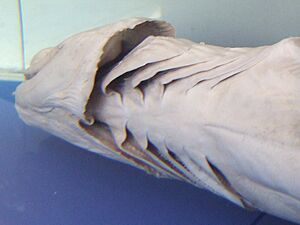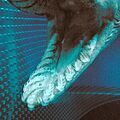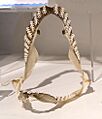Frilled shark facts for kids
Quick facts for kids Frilled shark |
|
|---|---|
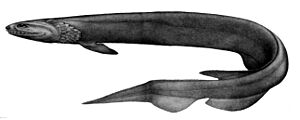 |
|
| At the Palais de la Porte Dorée | |
| Conservation status | |
| Scientific classification | |
| Genus: |
Chlamydoselachus
|
| Species: |
anguineus
|
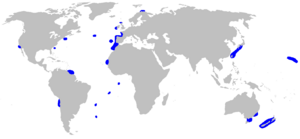 |
|
| Range of the frilled shark | |
The frilled shark (Chlamydoselachus anguineus) is a very unique deep-sea shark. It's often called a "living fossil" because it looks a lot like ancient sharks from millions of years ago. This shark has a dark brown, eel-like body that can grow up to 2.0 m (6.6 ft) long. Its name comes from the six pairs of gill slits on its throat, which have a frilly, fringed look.
Frilled sharks live deep in the Atlantic Ocean and Pacific Ocean. They usually stay near the ocean floor, where there's plenty of food. They eat squid, smaller sharks, and other fish. To find food, they sometimes swim up closer to the surface at night. When hunting, a frilled shark can bend its body like an eel and lunge forward. Its long, flexible jaws have about 300 needle-like teeth, perfect for grabbing and swallowing prey whole.
Female frilled sharks give birth to live pups, but without a placenta. The baby sharks grow inside egg capsules within the mother's body. They feed on yolk from their eggs until they are born. A frilled shark's pregnancy can last a very long time, up to 3.5 years! A mother can have 2 to 15 pups at a time. These sharks are sometimes caught by accident by fishing boats.
Contents
Meet the Frilled Shark: A Living Fossil
The frilled shark is special because it's considered a "living fossil." This means its body shape and features haven't changed much over millions of years. Scientists believe its family line goes back to the Carboniferous period, a very long time ago!
The first frilled shark was officially described by a zoologist named Samuel Garman in 1884. He named it Chlamydoselachus anguineus. The name comes from Greek and Latin words meaning "frill," "shark," and "like an eel."
Scientists first thought the frilled shark was related to very ancient sharks that lived even before dinosaurs. This was because of its long jaws, trident-shaped teeth, and how its jaws connected directly to its skull. Later, genetic studies suggested it's more closely related to modern sharks and rays, like the cow shark. However, some scientists still think it's so unique that it should have its own special group in the shark family tree.
In 2009, scientists found another type of frilled shark, called the southern African frilled shark (Chlamydoselachus africana). It lives in the Atlantic waters near southern Africa.
Where Frilled Sharks Live
Frilled sharks live in the deep parts of the Atlantic Ocean and Pacific Ocean. They prefer areas where the ocean floor slopes down from the land, called the outer continental shelf and upper continental slope. These places often have lots of food.
These sharks usually stay close to the ocean floor. However, they eat squid and fish that live closer to the surface. This means frilled sharks likely swim up at night to hunt for food, a behavior called diel vertical migration.
Frilled sharks are usually found at depths of 50–200 m (160–660 ft) in places like Suruga Bay, Japan. But they can be found much deeper, sometimes as deep as 1,570 m (5,150 ft). They tend to be solitary, meaning they usually live alone. However, sometimes many frilled sharks are caught together, suggesting they might gather in certain spots for mating.
In the eastern Atlantic, you can find them off the coasts of Norway, Scotland, Ireland, France, and Morocco. In the central Atlantic, they live near the Mid-Atlantic Ridge. In the western Atlantic, they are found near New England and Georgia in the US, and off the coast of Suriname. In the Pacific, they range from Japan to Australia, New Zealand, Hawaii, California, and Chile.
What Frilled Sharks Look Like
Frilled sharks have long, eel-like bodies. The two known species, C. anguineus and C. africana, look very similar. They are usually dark brown or gray. Female frilled sharks can grow up to 2.0 m (6.6 ft) long, while males are a bit smaller, up to 1.7 m (5.6 ft).
Their head is wide and flat with a short, rounded snout. Their eyes are medium-sized and don't have a special protective eyelid. The most striking feature is their mouth. It's very wide and filled with about 300 unique, trident-shaped teeth. Each tooth has a main point and two smaller points, like a tiny pitchfork. These teeth are arranged in many rows, about 19-28 rows in the upper jaw and 21-29 in the lower jaw. Their jaws can open very wide, allowing them to swallow prey much larger than their head.
At their throat, they have six pairs of long gill slits. The first pair forms a collar, and the tips of the gill filaments create a fleshy "frill," which gives the shark its name.
Their fins are quite small compared to their body. They have short, rounded pectoral fins. Their single dorsal fin is small and located far back on their body, near the tail. The pelvic and anal fins are large and rounded, also positioned towards the tail. Their tail fin is very long and triangular, without a lower lobe.
Frilled Shark Biology
Frilled sharks have a special way to stay afloat in the deep ocean. They have a skeleton made of cartilage (which is lighter than bone) and a large liver filled with low-density oils. These help them control their buoyancy and float easily.
They also have a special sensory system called a lateral line. This system has hair cells in grooves on their skin that are open to the water. This helps them sense movement, vibrations, and changes in water pressure around them, which is very useful for finding prey in the dark deep sea.
Like all animals, frilled sharks can have parasites, such as tapeworms and flatworms. They also have predators, likely other larger sharks, as some frilled sharks have been found with missing tail tips.
What Frilled Sharks Eat
The frilled shark's diet mainly consists of squid, smaller sharks, and other bony fish. About 60% of their diet is made up of different types of squid. Scientists know this by looking at the stomach contents of caught sharks, where they often find squid beaks. Since they live on the ocean floor, they might also eat dead animals that sink from the surface.
When hunting, the frilled shark might curve its body like an eel and use its fins to push off the water, allowing it to strike quickly. Its wide mouth and flexible jaws let it swallow prey that is more than half its own size! The 300 needle-like teeth are perfect for snagging the soft bodies and tentacles of squid.
Some scientists think frilled sharks might hunt with their mouths open. The contrast of their white teeth against the dark deep-sea environment could act as a lure to attract prey. They might also use suction to pull prey into their mouths. Studies of their stomachs often show little food, which suggests they either digest food very quickly or go for long periods between meals.
Frilled Shark Life Cycle and Reproduction
Frilled sharks don't have a specific breeding season. This is because their deep-sea home doesn't experience the same seasonal changes as the ocean surface. Male sharks become ready to reproduce when they are about 1.0–1.2 m (3.3–3.9 ft) long. Females are ready when they reach 1.3–1.5 m (4.3–4.9 ft) long.
Frilled sharks are ovoviviparous. This means the mother keeps the eggs inside her body, but the embryos develop inside egg capsules. The baby sharks hatch from these capsules while still inside the mother's uterus. They then feed on the yolk from their egg sacs until they are born.
A frilled shark embryo is about 3.0 cm (1.2 in) long when it starts developing. It has a pointed head, small jaws, and tiny external gills. As the embryo grows, its jaws develop later than in other sharks. The yolk sac provides food until the embryo is about 50 cm (20 in) long, when it disappears.
The pregnancy for a frilled shark is incredibly long, lasting up to 3.5 years! During this time, the embryos grow about 1.40 cm (0.55 in) per month. When they are born, the shark pups are usually 40–60 cm (16–24 in) long. A mother frilled shark typically gives birth to 2 to 15 pups, with an average of 6 pups per litter.
Frilled Sharks and Humans
Frilled sharks are usually caught by accident by commercial fishing boats. They get tangled in nets used for trawling, gillnetting, or longline fishing. In Japan, they are sometimes caught in nets meant for other fish or shrimp. Even though they can damage fishing nets, they have some value as fishmeal or for their meat.
In 2007, a Japanese fisherman caught a 1.6 m (5.2 ft) long female frilled shark near the surface. It was taken to a marine park but sadly died after a few hours. In 2014, a fishing boat in Australia caught another frilled shark at a depth of 1.0 km (3,300 ft).
Because frilled sharks reproduce very slowly and their deep-sea feeding areas can be affected by overfishing, the International Union for Conservation of Nature (IUCN) once listed them as "Near Threatened." However, they were later reclassified as "Least Concern," meaning they are not currently at high risk of extinction. Still, they are considered "Naturally Uncommon" in places like New Zealand, meaning they are not easily found in the wild.
Images for kids
See also



